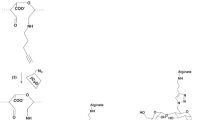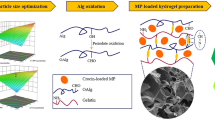Abstract
Casein serves as a protein extract from cow milk and its products; it is an available and cheap natural polymer material. Casein-based hydrogels have been extensively used in drug delivery systems due to their good biocompatibility and fast degradation. Although chemical crosslinking agents have been used for crosslinking of casein hydrogels, it is also associated with adverse effects and potential biotoxicity. In this work, casein was modified with methacrylic anhydride (MA). The functionalized casein (CaseinMA) possessed the ability to form hydrogels under 365 nm UV light in water solution without using toxic agents. Alginate was (0.4%, 0.8%, and 1.2%) found to successfully adjust the mechanical performance of CaseinMA hydrogels. The swelling property and degradation behavior indicated that the composite hydrogels had excellent water holding ability and degradability. MTT assay and hemolytic test demonstrated that CaseinMA/Alg hydrogels containing photoinitiator (Irgacure 2959) had good biocompatibility. At last, CaseinMA/Alg microspheres loaded with metformin hydrochloride (MET) were fabricated by using electrostatic droplet technology. The CaseinMA/Alg microspheres had a pH-sensitive property and slow sustained release as compared to mono-component microspheres in drug releasing test. CaseinMA/Alg hydrogels were confirmed that had good biocompatibility and mechanical properties; it is expected to be applied in many fields such as drug delivery system and wound management.
Graphical abstract











Similar content being viewed by others
References
Zhang M-K, Zhang X-H, Han G-Z (2022) Magnetic alginate/PVA hydrogel microspheres with selective adsorption performance for aromatic compounds. Sep Purif Technol 278:119547. https://doi.org/10.1016/j.seppur.2021.119547
Wang Z, Zhai X, Fan M, Tan H, Chen Y (2021) Thermal-reversible and self-healing hydrogel containing magnetic microspheres derived from natural polysaccharides for drug delivery. Eur Polymer J 157:110644. https://doi.org/10.1016/j.eurpolymj.2021.110644
Xiao P, Qi P, Chen J, Song Z, Wang Y, He H, Tang X, Wang P (2020) The effect of polymer blends on initial release regulation and in vitro-in vivo relationship of peptides loaded PLGA-Hydrogel Microspheres. Int J Pharm 591:119964. https://doi.org/10.1016/j.ijpharm.2020.119964
Xu X, Appel EA, Liu X, Parker RM, Scherman OA, Abell C (2015) Formation of Cucurbit[8]uril-based supramolecular hydrogel beads using droplet-based microfluidics. Biomacromol 16(9):2743–2749. https://doi.org/10.1021/acs.biomac.5b01048
Choi YH, Kim S-H, Kim I-S, Kim K, Kwon SK, Hwang NS (2019) Gelatin-based micro-hydrogel carrying genetically engineered human endothelial cells for neovascularization. Acta Biomater 95:285–296. https://doi.org/10.1016/j.actbio.2019.01.057
Liu J, Li J, Yu F, Zhao YX, Mo XM, Pan JF (2020) In situ forming hydrogel of natural polysaccharides through Schiff base reaction for soft tissue adhesive and hemostasis. Int J Biol Macromol 147:653–666. https://doi.org/10.1016/j.ijbiomac.2020.01.005
Lu Z, Liu S, Le Y, Qin Z, He M, Xu F, Zhu Y, Zhao J, Mao C, Zheng L (2019) An injectable collagen-genipin-carbon dot hydrogel combined with photodynamic therapy to enhance chondrogenesis. Biomaterials 218:119190. https://doi.org/10.1016/j.biomaterials.2019.05.001
Huang G, Huang H (2018) Hyaluronic acid-based biopharmaceutical delivery and tumor-targeted drug delivery system. J Control Release 278:122–126. https://doi.org/10.1016/j.jconrel.2018.04.015
Lakkakula JR, Gujarathi P, Pansare P, Tripathi S (2021) A comprehensive review on alginate-based delivery systems for the delivery of chemotherapeutic agent: Doxorubicin. Carbohyd Polym 259:117696. https://doi.org/10.1016/j.carbpol.2021.117696
Graça MFP, Miguel SP, Cabral CSD, Correia IJ (2020) Hyaluronic acid-based wound dressings: a review. Carbohyd Polym 241:116364. https://doi.org/10.1016/j.carbpol.2020.116364
Gelse K, Pöschl E, Aigner T (2003) Collagens–structure, function, and biosynthesis. Adv Drug Deliv Rev 55(12):1531–1546. https://doi.org/10.1016/j.addr.2003.08.002
Lindholm C, Searle R (2016) Wound management for the 21st century: combining effectiveness and efficiency. Int Wound J 13(Suppl 2):5–15. https://doi.org/10.1111/iwj.12623
Ma Q, Mohawk D, Jahani B, Wang X, Chen Y, Mahoney A, Zhu JY, Jiang L (2020) UV-curable cellulose nanofiber-reinforced soy protein resins for 3D printing and conventional molding. ACS Applied Polymer Materials 2(11):4666–4676. https://doi.org/10.1021/acsapm.0c00717
Picchio ML, Paredes AJ, Palma SD, Passeggi MCG, Gugliotta LM, Minari RJ, Igarzabal CIA (2018) pH-responsive casein-based films and their application as functional coatings in solid dosage formulations. Colloids Surf, A 541:1–9. https://doi.org/10.1016/j.colsurfa.2018.01.012
Mehra S, Nisar S, Chauhan S, Singh V, Rattan S (2020) Soy protein-based hydrogel under microwave-induced grafting of acrylic acid and 4-(4-hydroxyphenyl)butanoic acid: a potential vehicle for controlled drug delivery in oral cavity bacterial infections. ACS Omega 5(34):21610–21622. https://doi.org/10.1021/acsomega.0c02287
Nascimento LGL, Casanova F, Silva NFN, Teixeira A, Carvalho AF (2020) Casein-based hydrogels: a mini-review. Food Chem 314:126063. https://doi.org/10.1016/j.foodchem.2019.126063
Patwa R, Zandraa O, Capáková Z, Saha N, Sáha P (2020) Effect of iron-oxide nanoparticles impregnated bacterial cellulose on overall properties of alginate/casein hydrogels: potential injectable biomaterial for wound healing applications. Polymers 12(11). https://doi.org/10.3390/polym12112690
Rehan F, Ahemad N, Gupta M (2019) Casein nanomicelle as an emerging biomaterial—a comprehensive review, Colloids and surfaces. B, Biointerfaces 179:280–292. https://doi.org/10.1016/j.colsurfb.2019.03.051
Wan Y, Liu J, Guo S (2018) Effects of succinylation on the structure and thermal aggregation of soy protein isolate. Food Chem 245:542–550. https://doi.org/10.1016/j.foodchem.2017.10.137
Loessner D, Meinert C, Kaemmerer E, Martine LC, Yue K, Levett PA, Klein TJ, Melchels FP, Khademhosseini A, Hutmacher DW (2016) Functionalization, preparation and use of cell-laden gelatin methacryloyl-based hydrogels as modular tissue culture platforms. Nat Protoc 11(4):727–746. https://doi.org/10.1038/nprot.2016.037
Ondeck MG, Engler AJ (2016) Mechanical characterization of a dynamic and tunable methacrylated hyaluronic acid hydrogel. J Biomech Eng 138(2):021003. https://doi.org/10.1115/1.4032429
Maji K, Dasgupta S, Bhaskar R, Gupta MK (2020) Photo-crosslinked alginate nano-hydroxyapatite paste for bone tissue engineering, Biomed Mater (Bristol, England) 15(5):055019. https://doi.org/10.1088/1748-605X/ab9551
Kim SH, Yeon YK, Lee JM, Chao JR, Lee YJ, Seo YB, Sultan MT, Lee OJ, Lee JS, Yoon SI, Hong IS, Khang G, Lee SJ, Yoo JJ, Park CH (2018) Precisely printable and biocompatible silk fibroin bioink for digital light processing 3D printing. Nat Commun 9(1):1620. https://doi.org/10.1038/s41467-018-03759-y
Pinto RV, Gomes PS, Fernandes MH, Costa MEV, Almeida MM (2020) Glutaraldehyde-crosslinking chitosan scaffolds reinforced with calcium phosphate spray-dried granules for bone tissue applications, Materials science & engineering. C, Materials for biological applications 109:110557. https://doi.org/10.1016/j.msec.2019.110557
Latha MS, Rathinam K, Mohanan PV, Jayakrishnan A (1995) Bioavailability of theophylline from glutaraldehyde cross-linked casein microspheres in rabbits following oral administration. J Control Release 34(1):1–7. https://doi.org/10.1016/0168-3659(94)00088-C
Wang Y, Xue Y, Bi Q, Qin D, Du Q, Jin P (2021) Enhanced antibacterial activity of eugenol-entrapped casein nanoparticles amended with lysozyme against gram-positive pathogens. Food Chem 360:130036. https://doi.org/10.1016/j.foodchem.2021.130036
Wasupalli GK, Verma D (2020) Injectable and thermosensitive nanofibrous hydrogel for bone tissue engineering, Materials science & engineering. C, Materials for biological applications 107:110343. https://doi.org/10.1016/j.msec.2019.110343
Marlton SJP, McKinnon BI, Hill NS, Coote ML, Trevitt AJ (2021) Electrostatically tuning the photodissociation of the Irgacure 2959 photoinitiator in the gas phase by cation binding. J Am Chem Soc 143(5):2331–2339. https://doi.org/10.1021/jacs.0c11978
Werner JG, Nawar S, Solovev AA, Weitz DA (2018) Hydrogel microcapsules with dynamic pH-responsive properties from methacrylic anhydride. Macromolecules 51(15):5798–5805. https://doi.org/10.1021/acs.macromol.8b00843
Sali SS, Gould ML, Qasim M, Ali MA (2021) Biodegradable methacrylated casein for cardiac tissue engineering applications. Journal of materials chemistry B 9(6):1557–1567. https://doi.org/10.1039/D0TB02496A
Mocanu AM, Moldoveanu C, Odochian L, Paius CM, Apostolescu N, Neculau R (2012) Study on the thermal behavior of casein under nitrogen and air atmosphere by means of the TG-FTIR technique. Thermochim Acta 546:120–126. https://doi.org/10.1016/j.tca.2012.07.031
Wang J-H, Tsai C-W, Tsai N-Y, Chiang C-Y, Lin R-S, Pereira RF, Li Y-CE (2021) An injectable, dual crosslinkable hybrid pectin methacrylate (PECMA)/gelatin methacryloyl (GelMA) hydrogel for skin hemostasis applications. Int J Biol Macromol 185:441–450. https://doi.org/10.1016/j.ijbiomac.2021.06.162
Larosa C, Salerno M, de Lima JS, Merijs Meri R, da Silva MF, de Carvalho LB, Converti A (2018) Characterisation of bare and tannase-loaded calcium alginate beads by microscopic, thermogravimetric, FTIR and XRD analyses. Int J Bio Macromol 115:900–906. https://doi.org/10.1016/j.ijbiomac.2018.04.138
Rusu AG, Popa MI, Lisa G, Vereştiuc L (2015) Thermal behavior of hydrophobically modified hydrogels using TGA/FTIR/MS analysis technique. Thermochim Acta 613:28–40. https://doi.org/10.1016/j.tca.2015.05.018
Baybaş D, Serdaroğlu G, Semerci B (2021) The composite microbeads of alginate, carrageenan, gelatin, and poly(lactic-co-glycolic acid): synthesis, characterization and Density Functional Theory calculations. Int J Biol Macromol 181:322–338. https://doi.org/10.1016/j.ijbiomac.2021.03.128
Zandi N, Dolatyar B, Lotfi R, Shallageh Y, Shokrgozar MA, Tamjid E, Annabi N, Simchi A (2021) Biomimetic nanoengineered scaffold for enhanced full-thickness cutaneous wound healing. Acta Biomater 124:191–204. https://doi.org/10.1016/j.actbio.2021.01.029
Liang Q, Gao F, Zeng Z, Yang J, Wu M, Gao C, Cheng D, Pan H, Liu W, Ruan C (2020) Coaxial scale-up printing of diameter-tunable biohybrid hydrogel microtubes with high strength, perfusability, and endothelialization. Adv Func Mater 30(43):2001485. https://doi.org/10.1002/adfm.202001485
Tavafoghi M, Sheikhi A, Tutar R, Jahangiry J, Baidya A, Haghniaz R, Khademhosseini A (2020) Engineering tough, injectable, naturally derived, bioadhesive composite hydrogels. Adv Healthc Mater 9(10):e1901722. https://doi.org/10.1002/adhm.201901722
Günter EA, Popeyko OV, Belozerov VS, Martinson EA, Litvinets SG (2020) Physicochemical and swelling properties of composite gel microparticles based on alginate and callus cultures pectins with low and high degrees of methylesterification. Int J Biol Macromol 164:863–870. https://doi.org/10.1016/j.ijbiomac.2020.07.189
Jeon O, Bouhadir KH, Mansour JM, Alsberg E (2009) Photocrosslinked alginate hydrogels with tunable biodegradation rates and mechanical properties. Biomaterials 30(14):2724–2734. https://doi.org/10.1016/j.biomaterials.2009.01.034
Wang Q, Xie X, Zhang X, Zhang J, Wang A (2010) Preparation and swelling properties of pH-sensitive composite hydrogel beads based on chitosan-g-poly (acrylic acid)/vermiculite and sodium alginate for diclofenac controlled release. Int J Biol Macromol 46(3):356–362. https://doi.org/10.1016/j.ijbiomac.2010.01.009
Hassanpour M, Jafari H, Sharifi S, Rezaie J, Lighvan ZM, Mahdavinia GR, Gohari G, Akbari A (2021) Salicylic acid-loaded chitosan nanoparticles (SA/CTS NPs) for breast cancer targeting: synthesis, characterization and controlled release kinetics. J Mol Struct 1245:131040. https://doi.org/10.1016/j.molstruc.2021.131040
Vo PT, Nguyen HT, Trinh HT, Nguyen VM, Le A-T, Tran HQ, Nguyen TTT (2021) The nitrogen slow-release fertilizer based on urea incorporating chitosan and poly(vinyl alcohol) blend. Environ Technol Innov 22:101528. https://doi.org/10.1016/j.eti.2021.101528
Li P, Wang T, He J, Jiang J, Lei F (2021) Diffusion of water and protein drug in 1,4-butanediol diglycidyl ether crosslinked galactomannan hydrogels and its correlation with the physicochemical properties. Int J Biol Macromol 183:1987–2000. https://doi.org/10.1016/j.ijbiomac.2021.05.195
Funding
This work was financially supported by the Shaanxi Provincial Natural Science Basic Research Project, China (2018JM2037), the National Key Research and Development Program (2019YFC1606704), the Wisteria Program Project of Northwest University, China (363071902055), the Natural Science Foundation of Shaanxi Province (2020JQ-609), and the China Postdoctoral Science Foundation Project (2020M683701XB).
Author information
Authors and Affiliations
Corresponding authors
Ethics declarations
Conflict of interest
The authors declare no competing interests.
Additional information
Publisher's Note
Springer Nature remains neutral with regard to jurisdictional claims in published maps and institutional affiliations.
Supplementary information
Below is the link to the electronic supplementary material.
Rights and permissions
About this article
Cite this article
Wang, E., Wen, H., Guo, P. et al. Fabrication of methacrylated casein/alginate microspheres crosslinked by UV light coupled with Ca2+ chelation for pH-sensitive drug delivery. Colloid Polym Sci 300, 553–567 (2022). https://doi.org/10.1007/s00396-021-04917-3
Received:
Revised:
Accepted:
Published:
Issue Date:
DOI: https://doi.org/10.1007/s00396-021-04917-3




